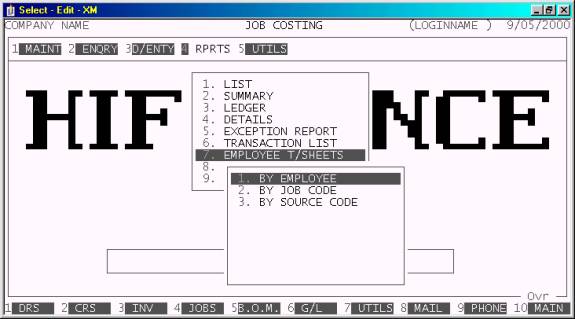HiFinance
4
SECTION
4.4.7 - JOB EMPLOYEE T/SHEETS
USAGE: To print a list of Timesheets from the Job
transactions file.
DISCUSSION: When you choose this option, the screen will
appear as follows:

Here you can choose the order in which you wish to
print the report.
Hint: If you intend to limit the report to a range of
Jobs, it is most efficient to print the report in the same order. Eg if you
wish to limit the report to a range of employees, the report will scan the
job-file faster if you also print the report in employee order.
Having chosen from the options, the following
questions will appear:
USE LONG FORMAT REPORT If you are using wide stationery, reply Y, otherwise reply N. This question will only be
displayed if the relevant option is set to A, see SECTION 7.1.2.
START A NEW PAGE ON
CHANGE OF KEY If you reply Y, HiFinance will start a new page each time the major key changes. In
either case, a sub-total will also be printed for each group of Jobs. If you
reply N, the report will be printed
continuously.
INCLUDE ALL JOB
TRANSACTIONS If you wish to print all Timesheet
transactions, you can answer Y here and you will not be
asked any of the range questions.
The following question asks you to enter both a
lower and upper limit. The upper limit must not be less than the lower limit.
The default answers define the extreme limits of the field. You do not have to
change all of these limits. Only change the ones you wish to, and tab past the
others.
EMPLOYEE CODE RANGE This is the Employee’s code.
JOB CODE RANGE This is the Job code.
SOURCE CODE RANGE This is the Source Code.
TRANSACTION DATE RANGE This allows you to limit the report to a range of due dates.
To start the report, press <Enter> through each field or simply press <F10>.
The report itself will detail the Transaction Date,
Transaction Audit Number, your Reference number, the Transaction Type, the Job
Code, and description, the Job Group, the Source Code and description, The
Units, Value and any other details. If you are printing the narrow form of the
report, some columns are left out, eg the Job and Source descriptions. At the
end of the report, all numeric fields are totalled.